How To Get A Good Watermelon
This post may contain affiliate links which won't change your price but will share some commission.

No one can tell you exactly how to pick a good watermelon, because so much of the flavor depends on growing and storage conditions. What I can give you are tips to teach you how to tell if a watermelon is ripe – PLUS – I'll tell you how to store a watermelon for best flavor and nutrition.
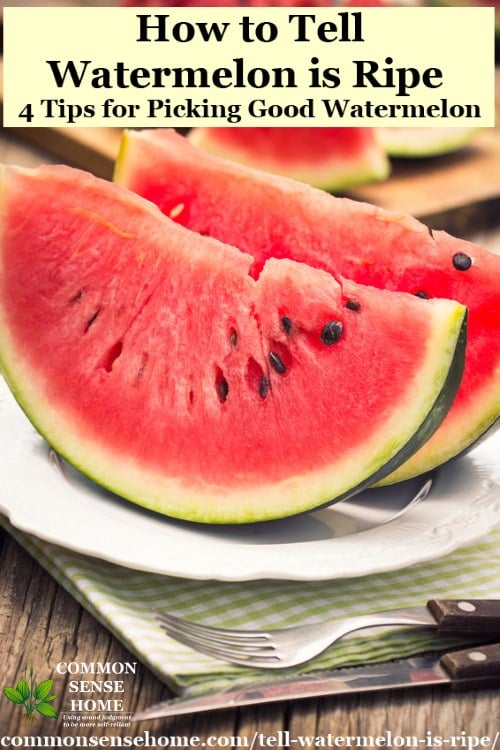
Contents
- How to Tell if a Watermelon is Ripe – 4 Tips to Help You Pick a Good Watermelon
- #1 – Check the Field Spot on the Underside of the Watermelon
- #2 – Check the Sound to See if a Watermelon is Ripe
- #3 – If you want a ripe watermelon, make sure your watermelon is at full growth
- #4 – Check the Little Curling Tendril Located Where the Watermelon Stem Joins the Main Vine
- #5 – Poke Your Blossom End (bonus from one of our reader comments)
- How to Store Watermelon
- Tips from "An Experienced Farmer" on How to Pick a Good Watermelon
- #1 – Look for the Field Spot
- #2 – Look for 'webbing'
- #3 – 'Boy' and 'Girl' Watermelons
- #4 – Pay Attention to the Size
- #5 – Inspect the Tail
- Good Watermelons for Northern Growers
- Picking the Perfect Watermelon
How to Tell if a Watermelon is Ripe – 4 Tips to Help You Pick a Good Watermelon
Good watermelon or bad watermelon? Growing conditions and storage make a huge difference in watermelon flavor and texture, but these tips will help you choose the best available watermelon. Some of these tips will help you tell when a watermelon is ripe on the vine, others apply to both garden watermelons and watermelons at the grocery store or farmers market.
Ripe watermelons are a little trickier to identify than muskmelons. Muskmelons slip right off the vine (i.e. come loose on their own) when ripe. Watermelons don't fall off the vine when ripe.
#1 – Check the Field Spot on the Underside of the Watermelon
The underside of the watermelon where it touched the ground should be buttery yellow to dark yellow in color. This is called the field patch or field spot. If the field spot as pasty white as a bald guy's head in the middle of a Wisconsin winter, it probably hasn't reach peak ripeness.
Different growing conditions and different types of melons will produce a range of colors (inside and out). Warmer weather usually yields a darker field spot.
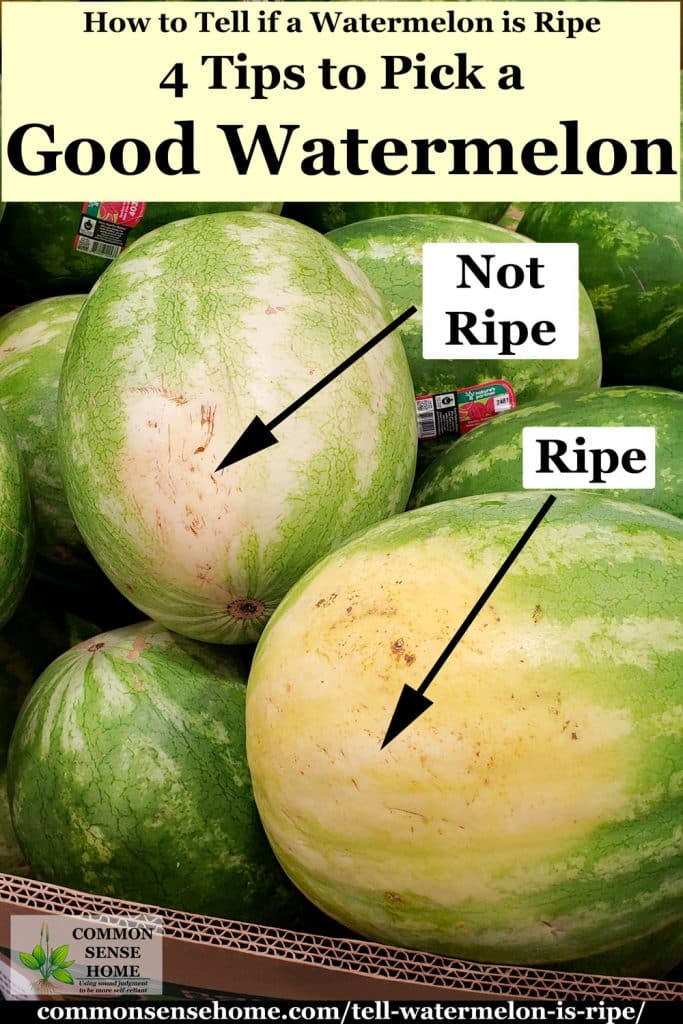
#2 – Check the Sound to See if a Watermelon is Ripe
This is a classic way to pick a good watermelon, and the internet is filled with descriptions of how a ripe watermelon should sound. Most say "flat" or "dull". I think that's a poor description. For my part, "flat and dull" is the sound you get when you rap on something like a giant zucchini – or an underripe watermelon.
A ripe watermelon should have a nice, deep hollow sound, more like a drum or knocking on a door. I did a quick video (below). My Powershot D10 doesn't quite do it justice, but you get the general idea.
#3 – If you want a ripe watermelon, make sure your watermelon is at full growth
This is for those trying to figure out how to tell if a watermelon is ripe in the garden. If you're watching the patch, you can tell when a particular watermelon is large, well filled out, and hasn't changed significantly in size for some time. Days to maturity will give you a rough estimate of expected watermelon ripening time. For first time growers, you can check the expected size on the package and weigh them if you want, but the best way to tell is to observe the growth habits of the watermelon.
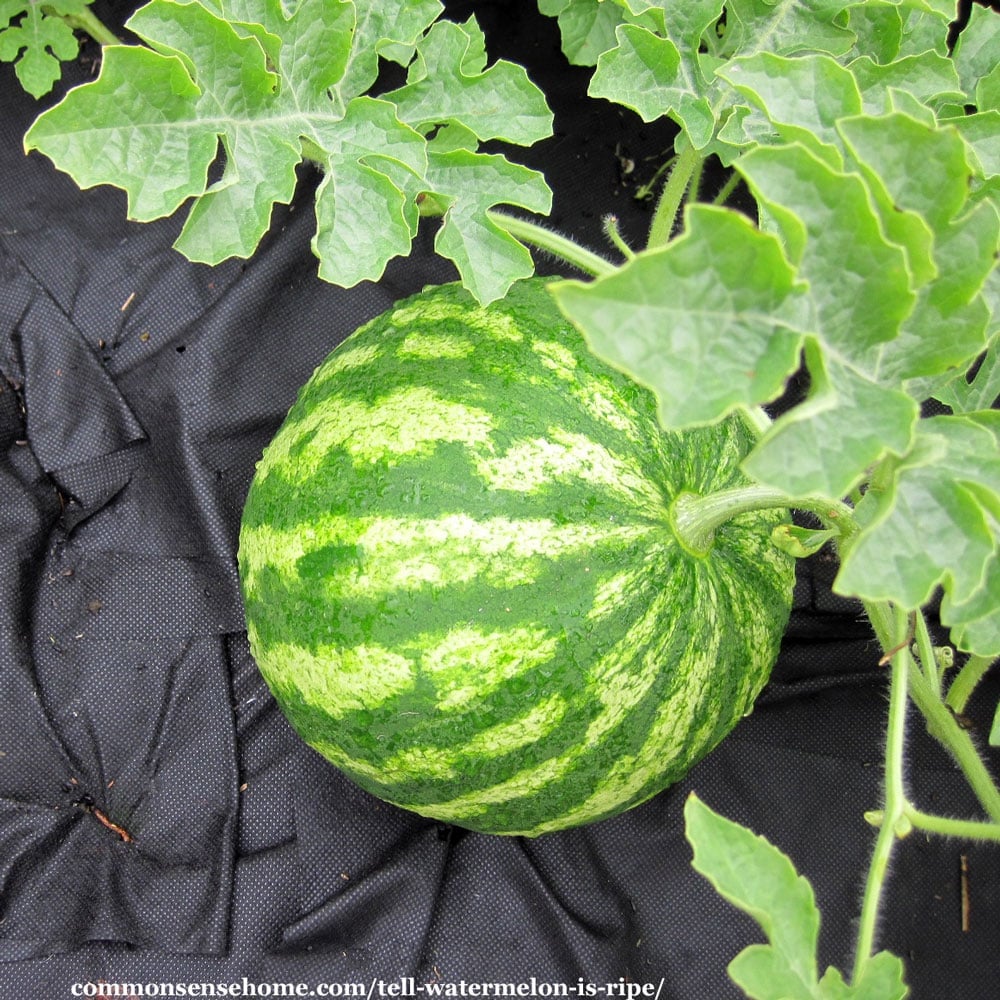
#4 – Check the Little Curling Tendril Located Where the Watermelon Stem Joins the Main Vine
This is another tip for checking ripe watermelons in the garden. Right where the stem to your melon joins the main vine, there should be a little curling tendril of vine. If the tendril is still green and springy, the melon is still growing.
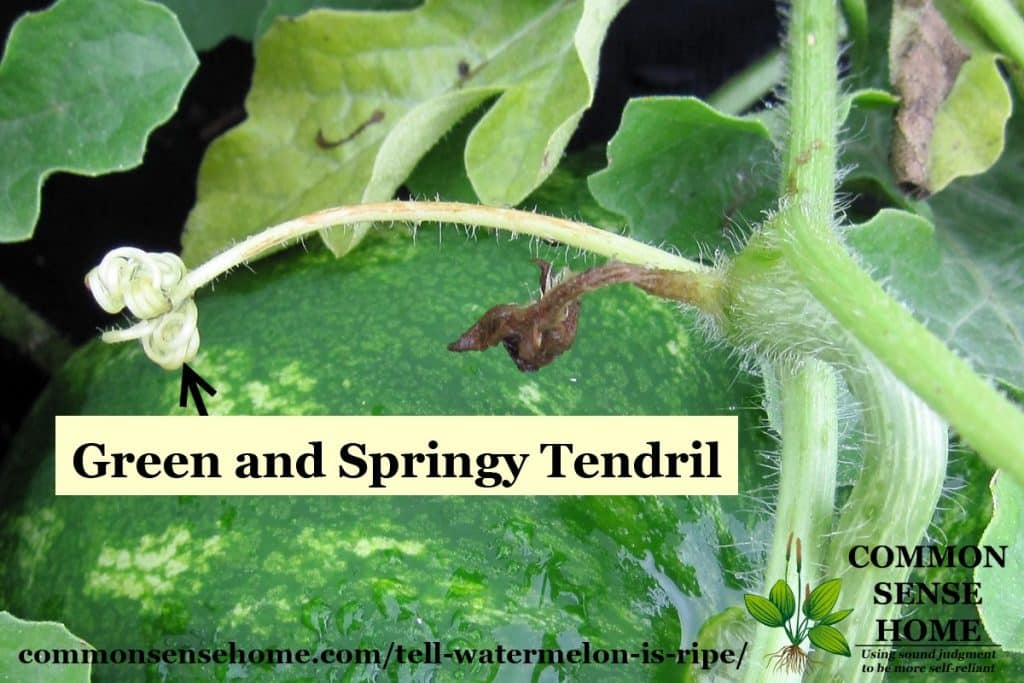
If this little tendril is brown and dried, odds are your melon is as ripe as it's going to get. Sometimes all your vines may start dying back before you've harvested, not just a tendril. Ready or not, your watermelons are done growing. Also, if it's been dry, sometimes the tendrils will dry back prematurely, so check the other signs first.
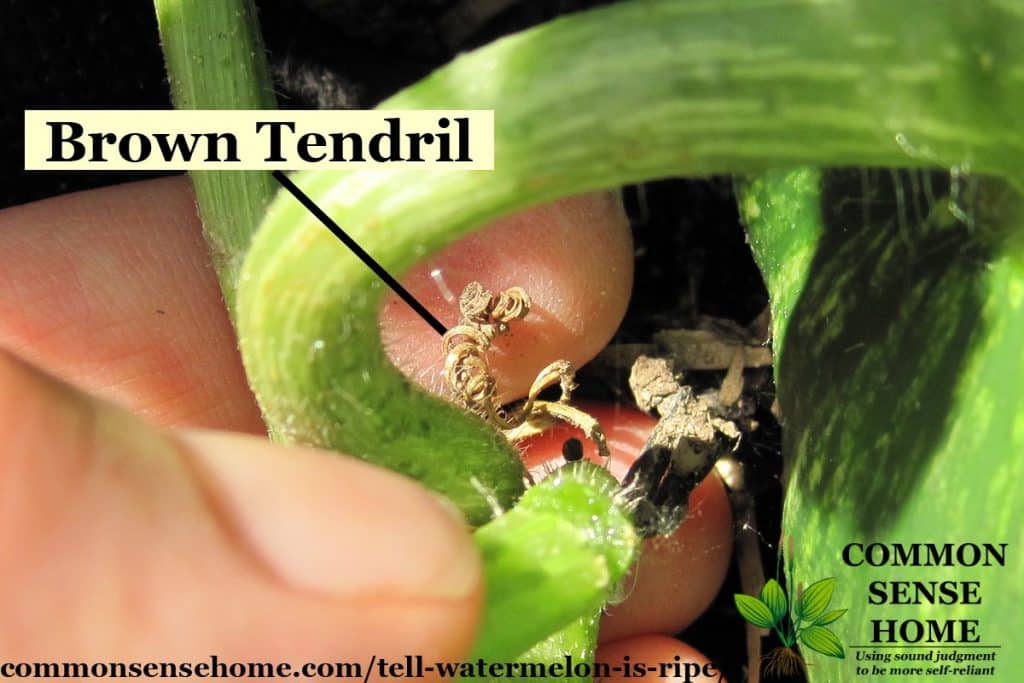
Jerry shares:
I mostly agree with the methods mentioned in this article.
My dad grew watermelons for many years in Florida so he had the advantage of following the fruit's development to complete ripeness. I have passed his knowledge on to many friends who confirm his method of ripeness selection.
Because so much depends on soil fertility and irrigation/rainfall sweetness is hard to determine. However, determining RIPENESS is a fairly full proof method. Thumping a melon doesn't mean much at all regarding sugar content.
In fact, the only indicator a consumer has in the market for determining the melon's RIPENESS is by pressing on the blossom end of the water melon to see how much "give" it has. The blossom end is opposite the stem end. If it is ripe there will be some give when pressed with the thumb. If it's not ripe it will be hard as a rock. A watermelon that's TOO ripe it will give little resistance, and likely be "mealy" inside.
It's always worked for me, for what it's worth.
Thanks, Jerry. I still find the "thump" helpful, and will give blossom end poking a try next time we pick a watermelon out at the store.
How to Store Watermelon
Before our melons were ready, I picked one up at the grocery store that I really shouldn't have bought. It was during our brief hot spell this summer, and the melons had obviously been stored too cold because they were chilled and sweating in the bins. Sure enough, I got it home and the flavor was bland and the texture was mushy. Melons like it warm! Storing watermelons at room temperature also makes them more nutritious.
From the article "Watermelon Fruit nutritional value health benefit" by Ray Sahelian, M.D.:
Watermelons stored at room temperature deliver more nutrients than refrigerated or freshly picked melons. Researchers tested several popular varieties of watermelon stored for 14 days at 70 °F, 55 °F and 41 °F. Whole watermelons stored at 70 °F, which is about room temperature in air-conditioned buildings, had substantially more nutrients. Compared with freshly picked fruit, watermelon stored at 70 °F gained up to 40 percent more lycopene and 50 percent to 139 percent extra beta-carotene, which the body converts to vitamin A. Watermelons continue to produce these nutrients after they are picked and that chilling slows this process.
The usual shelf life for watermelons is 14 to 21 days at 13 °C (55 °F) after harvest. At refrigerated temperatures, such as 41 °F, watermelon starts to decay and develop lesions after a week.
So don't store your melon in the fridge until it's cut (or chill only briefly right before serving). Once it's cut and refrigerated, eat it up ASAP.
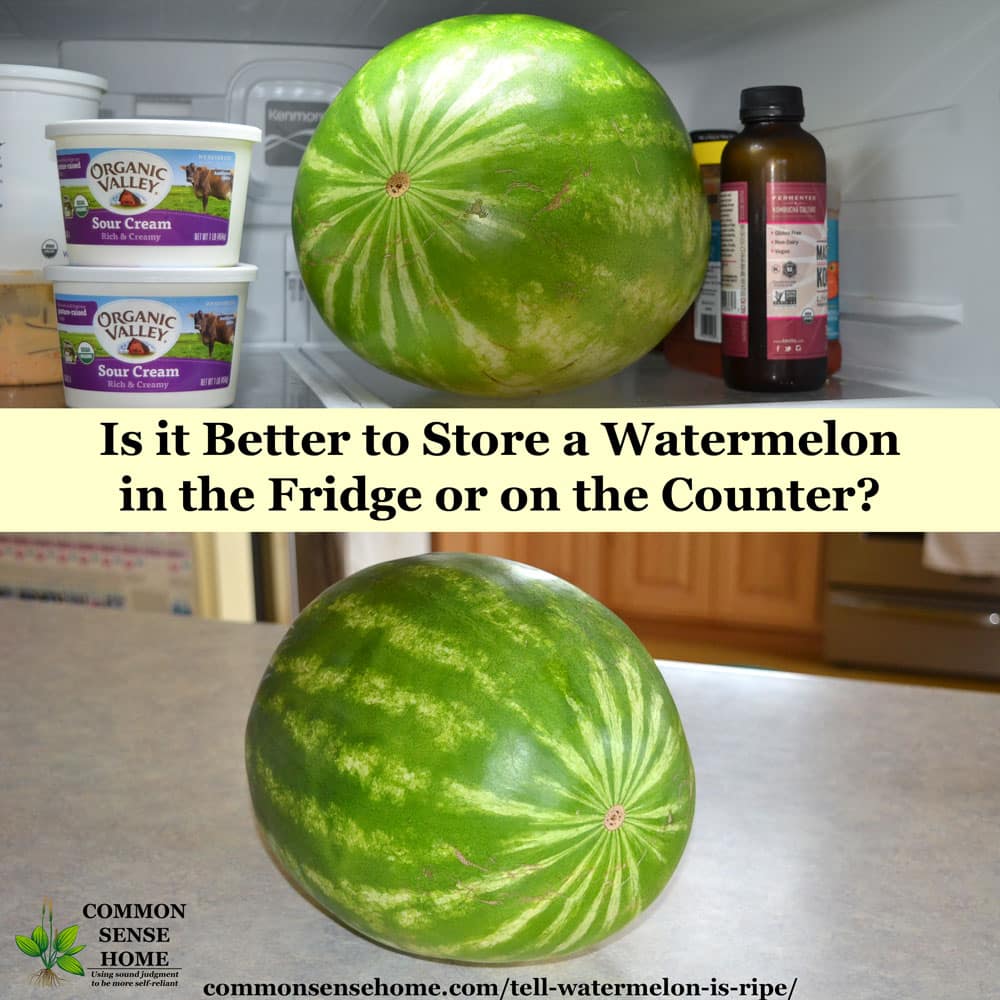
Tips from "An Experienced Farmer" on How to Pick a Good Watermelon
There are numerous web pages, photos and videos circulating on the internet right now (2018) claiming that they are "tips from an experienced farmer" on how to pick a good watermelon. Some of these are valid ways to check if a watermelon is ripe, some of them are flat out wrong. I suspect that the information was made up as a way to sell round watermelons with marks on them. I'll review these "tips" (listed in italics) to let you know what's right and what's wrong.
#1 – Look for the Field Spot
The yellow spot, known as the field spot, is the place where the watermelon rested on the ground. Ripe watermelons always have creamy yellow or even orange-yellow spots, not white. – CORRECT, as noted above
#2 – Look for 'webbing'
These weblike brown spots on the watermelon mean that bees touched the pollinating parts of the flower many times. The more pollination, the sweeter the fruit is. – WRONG
As noted by Texas A&M Agrilife Extension Plant Disease Handbook:
"Cracks, scarring, and pitting can be caused by mechanical damage when vegetables are young, Insects can also cause such injury. Animals, such as wild hogs and racoons, can cause more substantial damage."
In my experience, heavy exterior scarring often leads to tough or woody areas inside the fruit. (Mild scarring is not a problem.) More scars does not mean a sweeter watermelon.
#3 – 'Boy' and 'Girl' Watermelons
Many people do not know that farmers differentiate watermelons by gender. For example, 'boys' are bigger, have an elongated shape, and a watery taste. The 'girls' have a rounded shape and are very sweet. – WRONG
All watermelons come from female flowers, which have a small swelling at the base of the flower. There are no male watermelons. The shape of the watermelon is determined by the variety of watermelon. A round watermelon is not necessarily a good watermelon. For the melons pictured below, both were good, but the so-called "male watermelon" (the longer one) was sweeter then the round one.
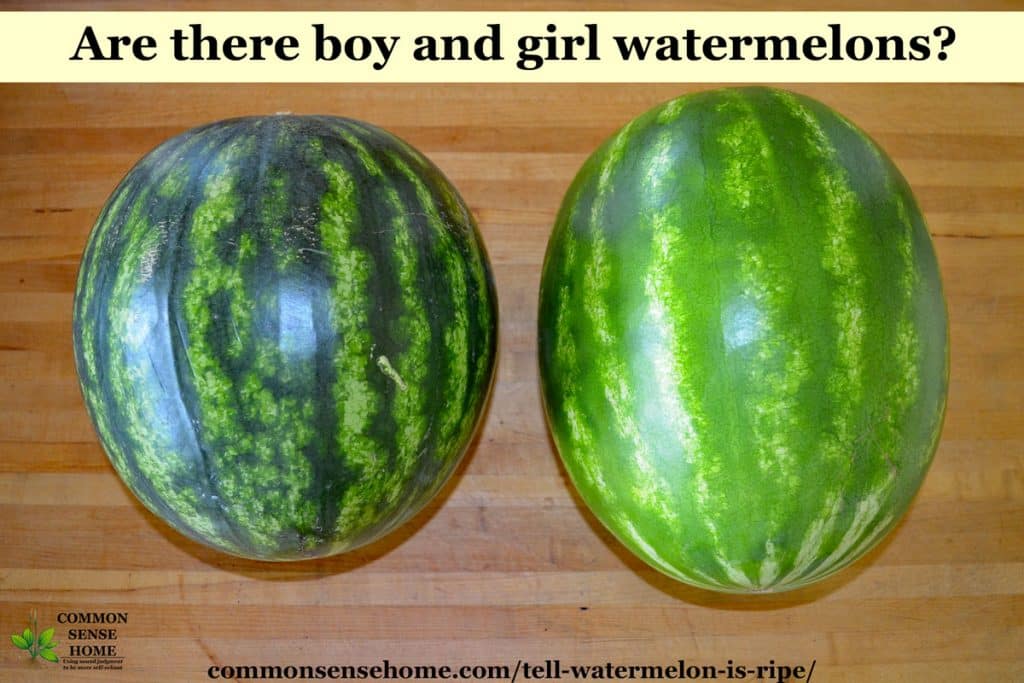
#4 – Pay Attention to the Size
It is better to choose neither the largest nor the smallest watermelon. Select an average-sized fruit. And note, please: large or small, the watermelon should feel heavy for its size. – SIZE DOESN'T MATTER
Check out a bin of watermelons at the grocery store, and you'll typically find that they are all similar in size. Other than selecting a ripe watermelon in the garden (that has reached full growth), size doesn't matter. If you start lifting watermelons, I bet in most cases you'll find that their weights are similar as well. Odds are that a given batch of grocery store melons all came from the same area and ripened under the same conditions, so this isn't a particularly useful tip.
#5 – Inspect the Tail
A dried tail indicates that the watermelon is ripe. However, if the tail is green, it probably means that the watermelon was picked too soon and will not be ripe. – MAYBE
As noted above, it's the tendril next to the watermelon on the vine that acts as a ripeness indicator. The vine itself may or may not indicate ripeness. A brown stem could mean that the watermelon was harvested some time ago, and it had time to dry, or it could mean that the plant was dying when the watermelon was harvested. You have no way to know for sure.
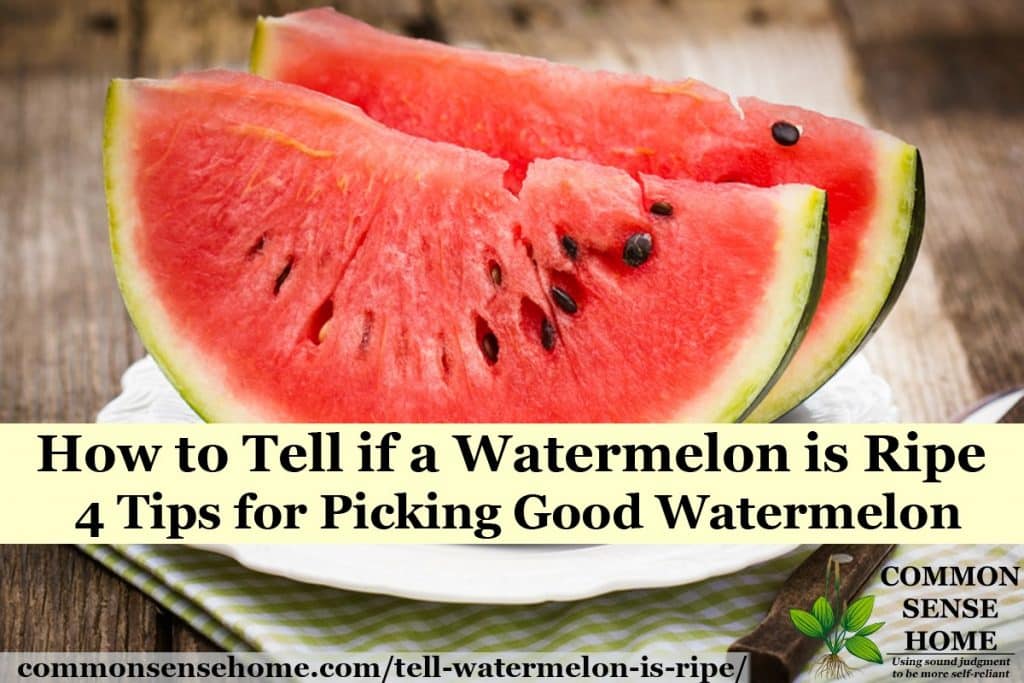
Good Watermelons for Northern Growers
Growing watermelons with a fairly short growing season can be a challenge, but with a little extra TLC we manage a good harvest. Some of our favorite watermelon varieties include:
- Orangeglo
- Blacktail Mountain
- Chelsea
- Yellow Petite
Even though Orangeglo and Yellow Petite don't get red, the same rules still apply for determining if they are ripe. Here's one of my favorite watermelon photos from a few years ago.
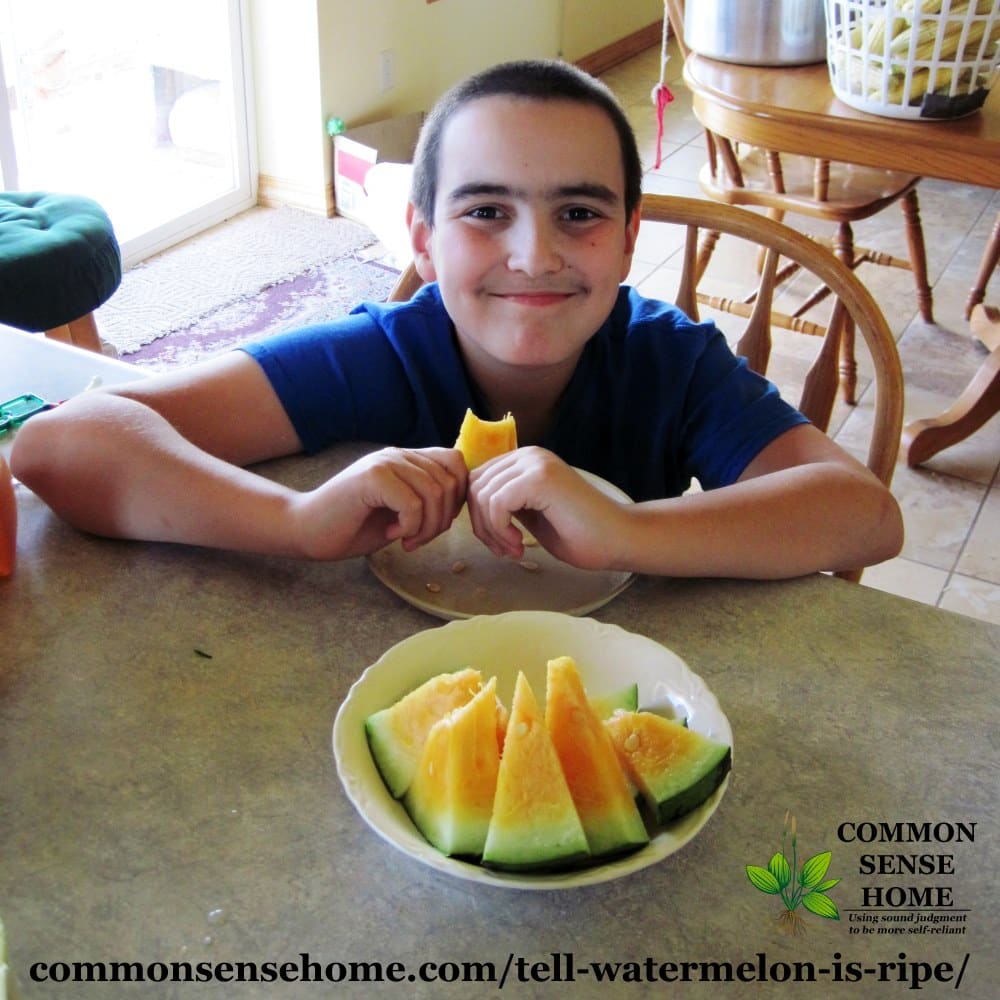
Picking the Perfect Watermelon
Back in my late teens and early 20's, my jobs at the family catering business included picking out the watermelons and carving the watermelon boats for parties. I was known as the resident watermelon expert, almost guaranteed to be able to pick out a good watermelon, if there was a good watermelon to be found. The last time I carved up a watermelon was for a Green Bay Packer party that we hosted for family and friends.
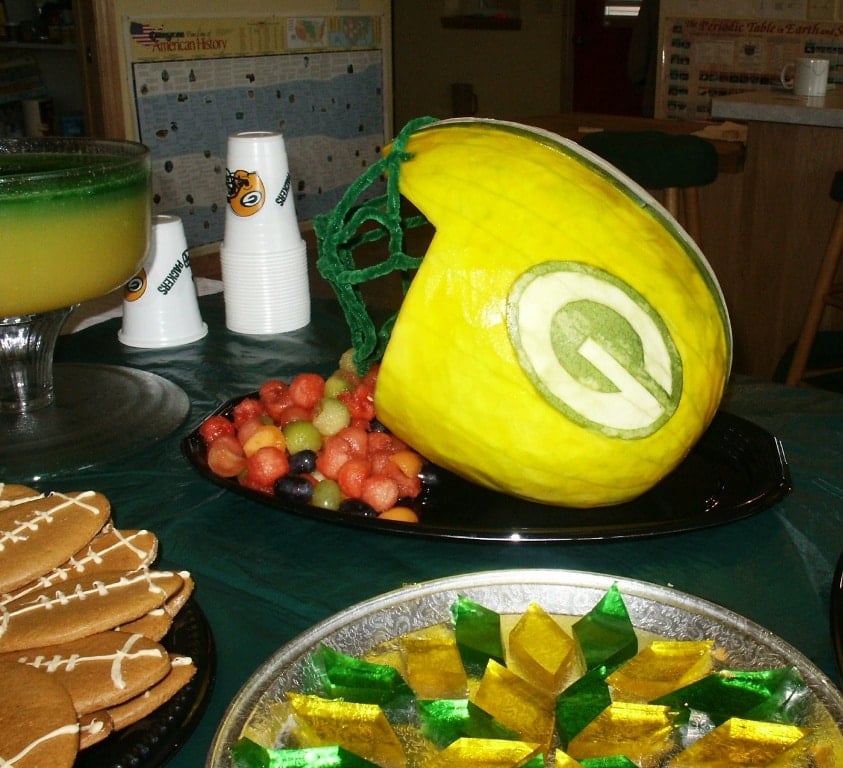
Unlike some fruits, watermelons do not ripen further once they are off the vine. Choose carefully, and store watermelons the right way to keep them flavorful.
Can you tell if a watermelon is ripe by smell? Nope. Uncut watermelons are less fragrant than muskmelons, because they don't have that open end where the vine was formerly attached. You will never find me sniffing watermelons in the grocery store, but you may find me sniffing cantaloupes. (I do my own stunts. 😉 )
Thanks for reading! We love your shares and comments. Did I miss any tips that you use to pick a good watermelon? Leave a comment and share your thoughts.
You may also enjoy:
- Watermelon Electrolyte Drink Recipe
- How to Grow Blueberries – Grow Your Own Superfruit
- Honey Sweetened Lemonade
Originally posted in 2014, updated in 2017, 2018.
How To Get A Good Watermelon
Source: https://commonsensehome.com/tell-watermelon-is-ripe/
Posted by: comptoneusive.blogspot.com

0 Response to "How To Get A Good Watermelon"
Post a Comment